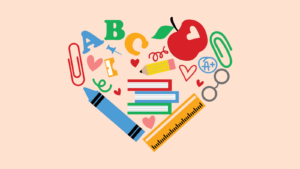by Irum Butt
As a teacher in Pakistan, I am always looking for new ways to engage the children in my classes so that they can develop their language skills.
One thing I have discovered is that one size does not fit all. One methodology, one approach will not enable all children to learn in quite the same way. The traditional classroom layout of a Pakistani classroom cannot accommodate all learners as we now know that children have different styles of learning such as audio, visual, kinesthetic or tactile. If the teaching style or approach does not engage a learner then he or she can lose interest and easily be distracted even to the point of showing hyperactivity.
I have discovered through my teaching that collaborative learning can benefit so many students and help them to be more engaged and to overcome language anxiety. We can never teach a second language with force or pressure and for children especially, it has to be enjoyable and if possible fun.
In this article, I would like to show how the colloborative learning method of storyboarding works best for me.
Storytelling is a very old tradition. It is a very simple form of entertainment and through centuries, it has been the way of passing down history, culture, teaching, manners and ethics. Who doesn’t love a good story, an interesting tale or a rhyme? And this applies to a great extent to children whose imagination is boundless.
In an ESL class, narratives can be the most powerful medium of communication among the learners.

Learning the target language can become easier while being engaged in a classroom task such as storyboarding and the discourse carried out by the group members who are engaged in creating a storyboard is always constructive.
All the ingredients of a narrative can be found in a storyboard activity which is a graphic representation of a story in terms of visuals, dialogues and narration.
While creating a storyboard, students listen and speak to each other, read and write in the target language. Above all, they use their thinking skills to fuel the other basic language skills and their thinking can easily be observed through their modified visual representations. The language age of a student in an ESL class can easily be determined by the help of storyboards. The themes, settings and characters they choose show their mindset. their likes, dislikes or problems, and observing them interacting can also show how they tackle classroom issues. With the help of a storyboard project, ELTs can enter their individual worlds.

Execution Plan
In Pakistani schools, projects are a way of life. Students are comfortable with them and happy to take part. If there are 30 students in a class, six groups can be made with five members in each. There are certain learning tasks while working on a storyboard project which can be assigned to each member of a group. For instance, if any member is good at drawing, he can make graphics/visuals for the storyboard, if someone likes conversations, he can help generate dialogues for the characters of the storyboard. My storyboard projects usually take about 4 to 5 hours to complete and so I allocate this time throughout a five day school week.
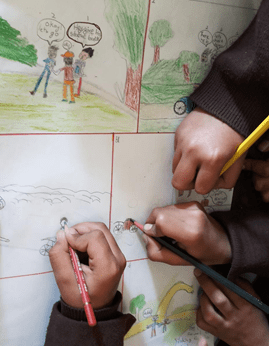
Group members draw and color together
Storyboard Prompts for students
- Choose any literary genre such as tragedy, comedy, fantasy etc. to write a narrative on.
- Choose a specific literary genre to make a storyboard on.
- Complete a story with the given story-starter.
- Choose from their first language narratives or any story from their specific culture and transform them in the target language.
Preliminary Support
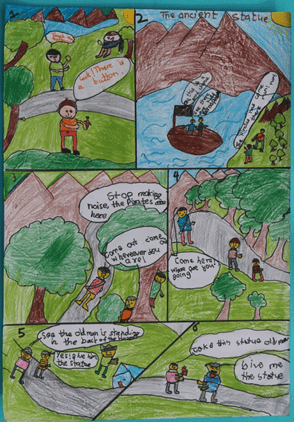
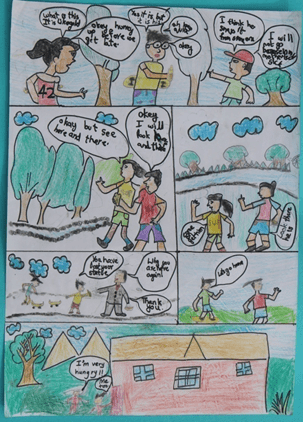
Students’ work can be used as a storyboard template
Instructions for the students while fitting a narrative into the storyboard template
- Prepare notes through brainstorming.
- Outline the story.
- Draw initial sketches
- Develop the scene.
- Add text to tell the story.
- Add colors.
Besides that, the students must be allowed to either consult a dictionary for suitable words or take help from their course books for drawing better images.

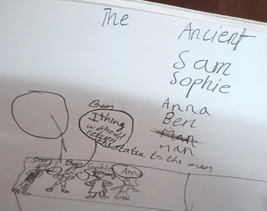
Students taking notes
Variations
If a class has an even number of students, each group will have an even number of group members too. If the class has an odd number of students, the group members will also be in an odd setting. A choice must be given to each student for selecting his group members whom he/she feels comfortable working with. Groups can be made up of only above average students, below average students or students of mixed ability.
Strengths of a Storyboard
- Peer-tutoring: A storyboard promotes peer-tutoring in an ESL class. For instance, in a mixed ability group, the more proficient language user can help the below average learner with ideas, vocabulary or grammar in the target language.
- Maintaining discipline: If there are gaps in our second language teaching methodologies, these gaps can turn into distraction. For instance, a child reaches a state of anxiety when he is not allowed to talk to his peers in a target language class which in turns fills up Krashen’s affective filters. However, group discussion can lower it down. A language class becomes more disciplined if the learners are kept busy talking while working on a storyboard project.
- Students’ autonomy: Learning with the help of the storyboards in an ESL class gives autonomy to the target learners for whom a storyboard appears to be a personal domain where no other classmate except their group members can have a right to intrude. The struggling ELLs can also work better on their own when they are given freedom finding solutions to their language problems. It is one of the misconceptions that these kids can learn better from a proficient learner. If the struggling ELLs are grouped together, they have no other option except to rely either on themselves or their peers and this is how they too make use of their problem-solving strategies in the given language task.
- Sense of responsibility: When the students are encouraged to work in teams on a storyboard project, they learn to give space to their peers. They become closer to each other. The opinions are often respected and praised by one another. There are rare chances of facing an argument among the team members because every team wants to bring something extraordinary in the given time-period. No doubt student-talking-time is increased but it does not turn that conversation into an unpleasant noise. Moreover, the students show full attendance too if some incentive is promised to be given at the completion of their project.
- Source of motivation: There is nothing tenser than sitting in an exam. Such tension can be mitigated by sharing a moment of pride from one’s life. For instance, the group photos holding storyboards can be turned into their name tags displayed on their seats during the final exams. It works as a source of motivation for all because an individual can be motivated in exams by reminding him of some pleasant memory of his life.
- Self-awareness: Students become aware of their strengths when they work on different learning tasks of the storyboard project. For instance, some like to draw images while some are good at coloring. Some students have neat handwriting and some can help others with the correct grammar. Besides that, they point out their own mistakes by reflecting on their work at the completion of their projects.
- Collaborative task: Storyboarding is the best way for ELTS to engage parents with their kids. Groups are allowed to take all possible support for their storyboard projects from their parents/guardians. This is how the parents get a unique chance to notice their children’s language growth.
Possible Problems faced by ELLs during a storyboard project
- One of the problems would be to convince and be convinced because there is a stream of ideas while working on a project. Each individual has an individual thought which at times need to be subtracted or multiplied to get the best outcome.
- Working with others can be quite challenging for such students who feel comfortable working either alone or in pairs. They can sometimes become troublesome for other partners because they enjoy their loneliness and feel intrusion into their personal world when they are made to sit in a group.
Conclusion:
Storyboard is a student-friendly language learning tool which caters for different learning styles. It has more strengths than weaknesses. For the successful language learning of an ESL class, ELTs may incorporate storyboarding into their language curriculum which could not only minimize language learning stress but also improve the language performance of ELLs.




